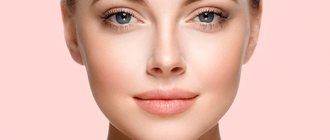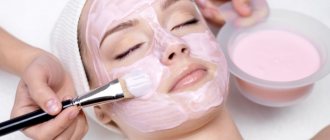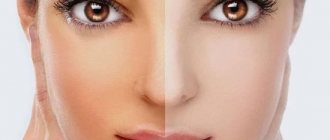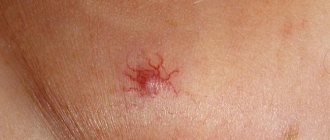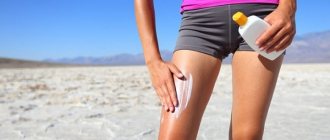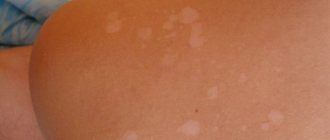Useful tips
Face after tanning (if the tan is even and provides natural harmony
with the skin color of the whole body) looks attractive - at least that’s what most of us think.
Tanning often helps hide minor imperfections in our skin.
, to a certain extent evens out the complexion.
However, it is the face (often along with the neck and forearms) that is usually most affected
from ultraviolet radiation. And that’s why many of us are concerned about the question: how to remove tan from your face?
Spots on the face after sunbathing - why they occur
An even tan on the face is, of course, cool, but often the face simply becomes covered in spots. And okay, if the problem was only aesthetic in nature
! In fact, even if you don’t vacation on the seas and oceans that often, the risks of skin diseases in these areas are very high.
According to experts from the World Health Organization, ultraviolet radiation is one of the main causes of non-melanoma cancers.
skin. In addition, it is one of the causes of malignant melanoma.
Melanin is responsible for uniform tanning on the face
The amount of melanin pigment produced by our skin depends on numerous factors, among which an important role
skin type plays a role. Also, the intensity of melanin production is influenced by the intensity of exposure to ultraviolet rays.
Actually, the tan itself is a natural protective reaction of the body to the effects of ultraviolet radiation. And if you, knowing your skin type and its characteristics, use this knowledge not only when relaxing on the beach
or when visiting a solarium, but also on ordinary weekdays, the risk of spots on the face after tanning is sharply reduced.
Diet and nutritional supplements
The skin can and should be protected from the inside. Free radicals increase the risk of skin cancer, antioxidants help block free radicals. Here are foods that contain antioxidants:
- Orange vegetables and fruits: carrots, sweet potatoes (sweet potatoes), pumpkin, melon. They contain beta-carotene, which prevents the appearance of sunburn and wrinkles.
- Citrus fruits: They contain vitamin C and quercetin.
- Spinach, kale and other leafy greens contain lutein.
- Tomatoes, watermelon and red peppers contain lycopene.
- Salmon, fish oil, flaxseed: Omega-3 fatty acids.
- Selenium-rich foods (walnuts and grass-fed meats). Selenium reduces the risk of skin cancer by 50%.
- Herbal teas high in antioxidants.
- Berries.
- Fish and some types of mushrooms are high in vitamin D.
- Olives, olive oil, nuts and seeds are a source of vitamin E, which improves skin health.
Skin types: how to protect your face from uneven tanning
In order for the tan to spread evenly on the skin of your face without leading to the formation of spots, it is not so important what type of skin you have in terms of the processes occurring in the cells of the epidermis
. These processes are often responsible for whether you have dry, oily, normal or combination skin.
More important is how different skin types differ depending on the amount of melanin they produce. genetic factors initially influence the proportion of melanin
. However, the intensity of exposure to ultraviolet rays, the main source of which is the Sun, does its dirty work, so to speak!
First skin type by color: albinos
The skin of people with this skin type is characterized by an almost complete inability
to the production of melanin from birth. In other words, this pigment is simply absent due to certain genetic preconditions.
Albinism and sun tanning are incompatible
Usually, such people have white not only skin, but also hair. Talking about people with albinism in the context of discussing the topic of facial tanning
, even unethical - albinos are, in principle, contraindicated from exposure to sunlight. But it’s also impossible not to mention them.
Second skin type by color: very light freckled skin
If the number of albinos born in the world is no more than one in 20 thousand, then there are much more people with very fair skin covered with freckles. They are also conventionally called people of the Celtic type
. By the way, freckles can cover not only the skin of the face, but also be present in large numbers on other parts of the body.
The face of people with this type of skin can get burned very quickly! A walk around the city on a hot afternoon is enough to give yourself a sunburn.
. But this does not mean that they cannot sunbathe at all! Such people can be advised to choose the right time for tanning, when the intensity of ultraviolet radiation is lower.
Find out the weather forecast and... ultraviolet radiation index
If you have this type of skin, then you simply must know about such a thing as the ultraviolet radiation index
(UFI). It is clear that it characterizes the intensity or level of ultraviolet radiation.
When planning to move around the city on a hot sunny day, people with very light, freckled skin should be interested in more than just the weather forecast
, but also by the UFI index.
Accordingly, the higher the UVI value, the more dangerous it is to be in the sun during this period, and even more so to deliberately sunbathe!
Typically the sun is most active between 10am and 4pm. However, at other times, if the UVI index level exceeds 3, you will need additional sun protection
. By the way, a normal tan for people with very light, freckled skin is also light. Everything else is a sunburn.
Third skin type by color: light skin
The difference between light skin and very light freckled skin is clear. But is it worth separating people with this skin type into a separate category? Rather yes than no.
And the reason here is not that people with fair skin should be less attentive to the same UVI index.
The reason is that people with fair skin tend to have a light brown tan. In fact, it is one of the most common skin types among Caucasians.
(along with the fourth type, which we will discuss below). Sunbathing with such skin is also recommended during hours when the UVI index does not exceed 1 or 2 (although, with appropriate protection, you can be in the sun for a short time even when the UVI index is 3).
Fourth skin type by color: olive skin
This is also a very common skin color; people with such skin are conventionally classified as Mediterranean type. The properties of this type of skin can be envied
– skin of this color often has excess subcutaneous fat, which prevents the early formation of wrinkles.
Blood pigments also affect skin color
It's not just melanin that affects our skin tone! In fact, two more pigments take part in this, so to speak, color formation: carotene and hemoglobin
. However, in people with the fourth skin color type, hemoglobin is not able to affect the shade (it is simply not visible due to the prevalence of melanin in the skin).
In terms of UV exposure, people with olive skin are better protected than people with the above skin color types. This means that such skin burns less often.
– for this there must be sufficiently long exposure to ultraviolet radiation. The tan is quite moderate, not very dark, but relatively uniform.
Fifth skin type by color: dark skin
Dark skin is less sensitive to ultraviolet rays. The main advantage of people with this skin color is that their tan is more even.
and, if you want, beautiful. It is characteristic not only of, say, immigrants from Asia or Indians, but also of many of our compatriots.
This does not mean that such skin does not need protection from ultraviolet radiation! People with dark skin may well suffer from sunburn.
. However, due to their dark complexion, the likelihood of sunburn spots appearing on the face of such people is very, very small.
The sixth skin type by color: conditionally black skin
People of the Negroid race have a similar skin color. The melanin content in the skin of such people is so high that they are best protected from ultraviolet radiation.
. However, even people with black skin can get sunburned, but to do so they will need to spend much more time exposed to intense sunlight.
Professional products
In addition to traditional methods, you will need to buy a daytime face whitening cream at the pharmacy, since professional cosmetics will help protect the skin from harmful factors. Good reviews about "Snow White" from Biocon. It contains natural ingredients and white clay (kaolin). In addition, the product has a strong UV filter and is equipped with an additional vitamin complex.
The Belita Vitex company offers a whole facial skin whitening system. It consists of a day cream (protecting from sunlight), a night cream (restoring balance and brightening) and a ready-made mask. The mask provides intense lightening, and the creams deeply moisturize and nourish. The composition includes natural ingredients, the products are hypoallergenic.
Photo - Belita Vitex
Products from Natura Siberica consist of unique components: Siberian juniper extract, acid, vitamins and mineral mixtures. They are aimed at deep skin regeneration, so they are used at night. Helps reduce hyperpigmentation and eliminate deep wrinkles. If you apply all the described methods together, i.e. masks, lotions and creams, then you will be pleased with the result within a few days.
How to whiten your face from tanning at home
But what to do if you are already burned? Most often, many of us try to whiten our faces from tanning at home. Let’s say right away that it’s not so easy to remove the tan from your face if you’re burned to the point of blisters.
. Actually, in this case, you should not be concerned about evening out your complexion, since this requires special measures (it is best to consult a doctor).
via GIPHY
It's another matter if the face, as they say, has become stained. , characteristic redness is observed on the surface of the skin of the face.
, which you can try to cope with at home, if you use ordinary means available in almost any house or apartment.
However, you should understand what you want to do: remove the redness of the face after tanning (that is, immediately after tanning!) or get rid of a tan on the face, which can be called old or persistent
. Let's start the review with the simplest remedy that will help cope with fresh, minor redness - water!
Water
Beneficial features:
Water is not only the most accessible remedy for sunburn, but also, in fact, the primary remedy. Its main task is to normalize heat exchange and “even out” the temperature in different areas of the skin.
How to use water for sunburn:
Yes, you can call a tan a sunburn without any embarrassment, since that is essentially what it is. To normalize heat exchange, you just need to lower your face into the water. The water should not be icy, but just cool.
You can also use cold compresses. Frequency of action - until pain decreases and complexion evens out. Usually the redness subsides in about an hour or less (in simple cases)
. And God forbid you use ice for prolonged cooling of burnt areas - you will only worsen the situation, as this can lead to the death of the epithelium.
Dairy
Beneficial features:
Even children, it seems, know about the beneficial properties of sour cream, whey or kefir applied to areas of skin burnt after sunbathing. However, no one can really say what causes them.
In fact, if we are talking about a severe sunburn, then dairy products will do more harm than good! For moderate burns, sour cream or kefir provide sufficient skin hydration
, increasing its elasticity. The difference from water is that sour cream stays on the body better and takes longer to heat up!
How to use dairy products:
firstly, if you have dry skin, then you should use sour cream; for oilier skin, kefir (even low-fat) or the same serum is suitable. Secondly, you should apply a thin layer of the dairy product to the reddened areas of the body, wait until the itching and redness goes away, then rinse with cool water.
Aloe juice
Beneficial features:
Aloe juice is considered a reliable remedy that is highly effective in treating not only small cuts or wounds, but also in the treatment of skin diseases. Sunburns begin to bother you less, and dark areas of the skin become somewhat lighter.
How to use aloe juice for sunburn:
cut off the aloe leaves, wash them thoroughly, chop and squeeze out the juice. After this, you need to spread the resulting paste onto the damaged (reddened) areas of the skin on the face, leaving them for literally a couple of hours. You can cool it a little beforehand.
Parsley
Beneficial features:
Parsley is a well-known antioxidant that has a beneficial effect on the skin, preventing it from aging. By the way, since our skin is regularly (to varying degrees) exposed to ultraviolet rays, it is recommended to use parsley on a regular basis.
How to use parsley for sunburn:
There are several methods available. Firstly, finely chopped parsley can be mixed, for example, with sour cream, and then spread in a thin layer on the burnt area. Secondly, you can treat your face with an infusion of fresh or dried herbs.
Finally, if you make ice cubes from the parsley infusion, you can rub them on your skin (but remember not to let the ice sit on the burned areas for too long).
Lemon juice
Beneficial features:
Lemon juice has a number of well-known beneficial properties that allow it to be used not only to lighten tanned skin. Lemon juice is a constant ingredient in various scrubs and masks to brighten and even out complexion.
How to use lemon juice for sunburn:
Let's start with the fact that lemon juice cannot be used to remove fresh redness that occurs immediately after sunbathing. In the case of sensitive skin, this is even dangerous! In this situation, it is recommended to dilute lemon juice with cucumber juice, mineral water or another component.
Treat your skin with nourishing cream
If you have normal or oily skin, you can apply a slice of lemon to your face several times a day (4-5 times), leaving the juice on your face
within five to ten minutes. After this, you need to wash your skin with warm water (if the juice is very diluted, you don’t have to wash it off). It is recommended to apply a thin layer of nourishing cream to the treated skin.
Vinegar
Beneficial features:
vinegar allows you to effectively even out your complexion, evenly removing tan and spots formed by improper tanning. Obviously, such an active agent as vinegar must be used to remove old tan, since it is unacceptable to apply a vinegar solution to the skin immediately after a sunburn.
How to use vinegar against tanning:
Besides the fact that vinegar is not used to normalize the situation on skin that has just been sunburned by ultraviolet radiation, it is also not recommended for use on sensitive skin.
In any case, vinegar is usually diluted with water in equal proportions. a cotton pad soaked in the solution.
, taking the longest to process particularly dark areas. Then leave the resulting layer for 15 minutes, then rinse it off with warm water.
Hydrogen peroxide
Beneficial features:
Probably the most effective bleaching agent that allows you to quickly remove tan from your face at home is
hydrogen peroxide
. However, it is also the most dangerous remedy in terms of possible undesirable consequences, so it is often recommended to consult cosmetologists for skin peeling using peroxide.
How to use vinegar against tanning:
In order not to completely burn the skin, it is recommended to use peroxide to remove tan, depending on your skin type -
dry, normal, oily
. Don't use peroxide more than once a week if you have dry skin. Obviously, peroxide is not particularly suitable for quickly and safely removing tan from the face with dry skin.
For oily skin, you can treat your face with peroxide no more than twice a week. In this case, the solution should be three percent - no more! You can also use various masks based on hydrogen peroxide
, however, they should also be selected and manufactured based on the recommendations of professionals who take into account your skin type.
Lemon
Lemon juice contains enzymes that break down dead cells, causing the skin to renew and whiten. You can make the following skin lightening products with lemon:
- A mask that will additionally soften dry skin and make it elastic. To do this, mix a few drops of lemon juice with sour cream and honey (1 tsp each), apply to your face for 15 minutes and rinse.
- Make the following mixture for the mask: 1 tbsp. l. sugar, 2-3 drops each of lemon juice and olive oil.
- Wipe the skin with lotion to lighten: chop 1 lemon with peel, pour a glass of boiling water for a day, then strain and apply.
How to quickly remove tan from face
There are many more products that can remove tan from your face at home. You can also try a mask made from cucumber, strawberry, apple, citrus fruits, tomato and other products
. Methods of modern cosmetology can also help quickly remove tan from your face. It should be borne in mind that you will not be able to quickly remove a fresh tan with their help - it is simply dangerous for the skin.
So, if your tan cannot be called fresh, and you definitely don’t think it’s beautiful, it is recommended to contact a cosmetologist
. A modern cosmetologist is armed with not only photo correction and laser therapy, but also the same chemical peeling of the facial skin.
What principle is used to remove tan from the face?
Regardless of which method of removing tan from your face is offered to you, the principle of cleansing
consists of exfoliating the epidermal cells that have undergone pigmentation, as well as subsequently evening out the color of the skin of the face.
As for peeling, we have already discussed this above. The difference between home facial cleansing and professional facial cleansing is that in the second case, peeling is carried out in a cosmetology salon
professionals. In this case, the range of products used may be somewhat wider, including specific cosmetic products.
Photo correction
Photocorrection of age spots is also called skin phototherapy or photorejuvenation
. If during tanning ultraviolet radiation affects the skin in such a way that it activates the production of pigment, then during photocorrection the light beam affects the pigment, as if washing it away.
This is a fairly conventional description of how the photorejuvenation procedure works. The main difference from laser rejuvenation
(this procedure will be discussed below) is that during photorejuvenation the skin is exposed to an impulse (electromagnetic radiation), eliminating the so-called skin pathologies.
For pulsed radiation, if the parameters are correctly selected, melanin becomes a similar pathology. This procedure is highly effective
, however, the use of photo correction of age spots is possible only when the tan on the face is at least 3-4 weeks old.
Laser rejuvenation
Another way that allows you to get rid of sun tan quickly and effectively is the so-called laser rejuvenation
. Despite the fact that laser rejuvenation and photorejuvenation are fundamentally different from each other, many people mistakenly confuse these two procedures.
In fact, these procedures have only one thing in common - the effect on the skin through light energy
. Laser rejuvenation is a much more drastic procedure that can be recommended to remove more stubborn tans.
How many laser rejuvenation procedures are needed to remove tan from the face?
This procedure is quite traumatic (especially some of its varieties - for example, fractional laser thermolysis). The intensity of the effect depends on the depth of pigmentation
. The recovery period, which can range from three to seven days, also depends on this. But you can get by with one or two procedures.
It may seem strange to someone that a light beam removes the consequences formed as a result of exposure to, in fact, another light beam
. In fact, laser rejuvenation does not affect the entire tan, but the most pronounced areas of pigmentation.
Lotions
Reviews claim that you can quickly whiten your face with tonics for washing. Various herbs can be used to prepare them: chamomile, bearberry, jasmine, green tea. If your face is very tanned, then wash your face with a decoction of chamomile - take 3 tablespoons of color per 1 glass. This normalizes the functioning of the sebaceous glands and significantly lightens the skin.
A good whitening tonic is made from cucumber and lemon juice. For a glass of mineral water, take one cucumber and half a lemon. Juice is squeezed out of the fruit. The mixture is left to infuse overnight, and in the morning you can wash your dark or red face. This lotion needs to be prepared every three days as it spoils quickly.
Photo - Lemon with cucumber
It is correct to use tonics and masks in combination, then the effect will come as quickly as possible - after the third use.
Video: how to whiten skin https://www.youtube.com/watch?v=PamqrL539wc
Skin care rules after whitening
After lightening procedures, the skin has become softer and more sensitive, and therefore requires special care. Here are a few points that you should not miss when caring for it in the next few days after whitening:
- Use sunscreen when going outside, or regular creams that have SPF;
- Use a moisturizing, nourishing or regenerating cream twice a day: apply to lightened skin in the morning and evening;
- For some time, forget about using lotions with a drying effect, especially those containing acids;
- Do not walk under intense sun rays.
